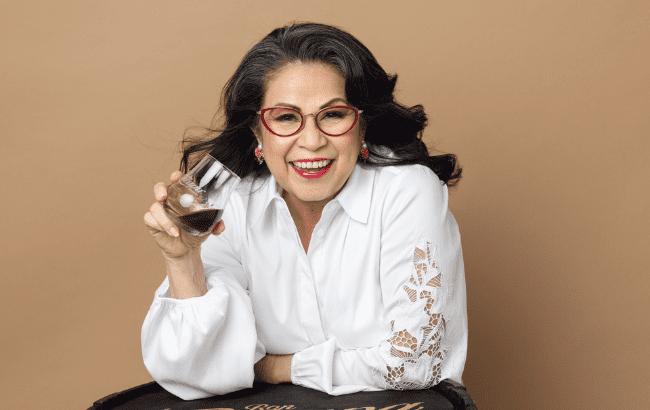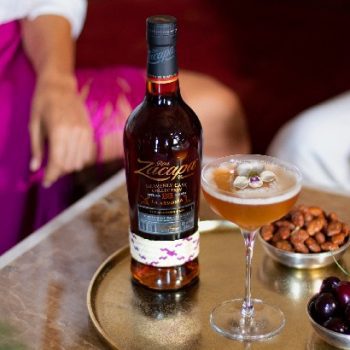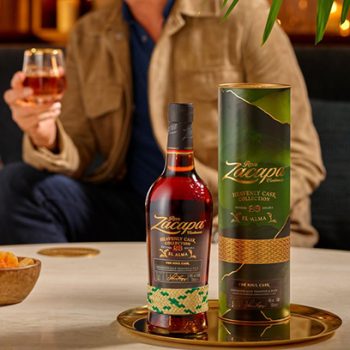Lorena Vásquez’ 40-year rum journey
By Georgie CollinsAfter joining Zacapa at the age of 29, Lorena Vásquez quickly rose through the ranks of the Guatemalan distillery. The master blender tells us about her 40-year journey with the rum brand, and shares the lessons she’s learned along the way.

Nicaragua-born Vásquez moved to Guatemala in her twenties, along with her husband and first child. Her background in pharmaceutical chemistry, alongside a natural and highly accurate talent for taste and smell, led her into the spirits industry. “When the opportunity to move into rum blending arose, I jumped at it,” Vásquez explains, noting that both her scientific and olfactory skills equipped her to understand the technical aspects of the process and bring her expertise to the art of rum blending.
However, Vásquez joined the spirits industry at a time when women did not typically hold such high or prestigious positions within the sector. “I quickly rose through the ranks, despite working in a male-dominated industry – which certainly wasn’t easy.” However, over the decades, Vásquez’s gender has always come second to her skills, and her legacy has instead been built on a deep passion for rum and her work in advancing the art of blending, elevating the solera method, and creating exceptional expressions that showcase the richness and complexity of Guatemalan rum.
“Being one of the few female master blenders in the industry, I’m proud to have contributed to shaping Zacapa’s reputation as one of the finest luxury rums in the world. My journey has been about blending tradition with innovation, and I hope to inspire the next generation of rum producers while continuing to uphold the values of quality and dedication that Zacapa is known for.”
Vásquez’ utilisation of the solera system, which sees the rum journey through a carefully selected multitude of cask types and styles, has enabled Zacapa to achieve its renowned complexity and rich flavour profile. “Unlike traditional ageing methods, where rum matures in a single barrel for a set time, the solera system involves progressively blending younger and older rums through a series of casks,” Vásquez explains. “This ensures each bottle contains a mix of rums of varying ages, contributing to Zacapa’s signature depth.”

The ageing takes place in the Guatemalan highlands at 2,300 meters (7,500 feet) above sea level, where cooler temperatures slow maturation, allowing for a more refined and complex flavour development. The rum is typically aged in a sequence of barrels that previously held the likes of American whiskey, Sherry, and Pedro Ximénez wine, each imparting unique characteristics.
By balancing younger, vibrant rums with older, deeply complex ones, Vásquez can ensure that each batch maintains the distinctive Zacapa profile. Constant tastings and evaluations are conducted, with slight adjustments made to accommodate natural variations in ageing while preserving the brand’s hallmark notes of caramel, vanilla, dried fruit, and spice. However, a consistent base of aged rums remains in the solera system at all times, preventing drastic shifts in flavour and ensuring every bottle reflects Zacapa’s luxurious character.
Category evolution
Despite this being a well-honed blending method for Zacapa, Vásquez has observed an evolution of the wider category in her four-decade tenure in the industry.
“The rum industry has evolved significantly over the years, particularly with the growing demand for premium and craft spirits,” she notes. “There has been a shift toward producing rum with a focus on craftsmanship, ageing techniques, and unique flavour profiles, much like the attention given to fine whisky, gin, and other spirits. The rise of premium rums has been driven by the broader trend of consumers seeking more sophisticated, flavourful, and authentic experiences. As people have started to appreciate the nuances of rum – its ageing, ingredients, and production methods – there has been an increasing interest in craft rum.”
Vásquez adds that these rums, often made in smaller batches and with more attention to detail, have gained a loyal following. In addition, rum producers have become more experimental with ageing processes, barrel types, and blending techniques, creating a diverse range of expressions that appeal to both connoisseurs and casual drinkers alike.
“Zacapa, with its high-altitude ageing process, first-press sugarcane honey, and solera system, has been at the forefront of this transformation,” she notes. “The brand has played a crucial role in elevating rum into the premium spirits category, showing the world that rum can be as complex, refined, and enjoyable as whiskey or other luxury spirits.”
However, Vásquez says it isn’t just her skills as a blender that contribute to the flavour and subsequent successes of the liquid produced by the brand, recognising that the Guatemalan terroir is also a contributing factor to the overall success of the product, and what “truly shapes the flavour profile of Zacapa”.

She adds: “One of the standout elements [of Zacapa] is the use of first-press sugarcane honey, which comes from sugarcane grown in the volcanic lowlands. The volcanic soil is rich in minerals, which gives the sugarcane a natural sweetness and depth, making it a smoother, more refined base compared with traditional molasses-based rums.”
Furthermore, she says the warm tropical conditions in the lowlands, where the sugarcane is grown, and the cooler, more humid conditions in the highlands, where the rum ages, create a balance between rich sweetness and a nuanced depth. “All these elements – volcanic soil, high-altitude aging, and diverse climate – come together to create the smoothness, depth, and elegance that define Zacapa Rum.”
Social impact
Beyond the liquid, Vásquez is also an advocate for the brand’s work empowering Guatemalan women by teaching them the art of weaving petates, a traditional woven material, via the Zacapa Petate Initiative.
“This initiative is not just about creating beautiful, hand-made products; it’s about giving these women a sustainable income while also preserving an important craft that’s been passed down through generations,” Vásquez explains. “In the Guatemalan region, women are trained to weave these mats using locally sourced materials, like palm leaves, which are abundant in our area. By being part of this project, these women gain a fair wage, independence, and the opportunity to improve their communities. It’s really about more than just the bands. This programme highlights the beauty and importance of traditional artistry and cultural heritage.
“At Zacapa, we’re committed to sustainability, social responsibility, and community empowerment. The Petate Initiative is one way we strengthen our bond with the local community while preserving both our culture and craft.”
In addition, Vásquez speaks of Zacapa’s ongoing commitment to creating a platform for creatives within the Latin American community, continuing to deepen the brand’s support for emerging talent and creative expression. “In both 2023 and 2024, Zacapa partnered with the Latin American Fashion Summit to uplift the region’s visionaries, and in 2025, you can expect to see even more initiatives that empower creatives and celebrate their craftsmanship. We’re especially excited about an upcoming collaboration that will further showcase the incredible creative talent shaping Latin American culture,” she says.
Related news
Money and safety concerns stop young people going out
